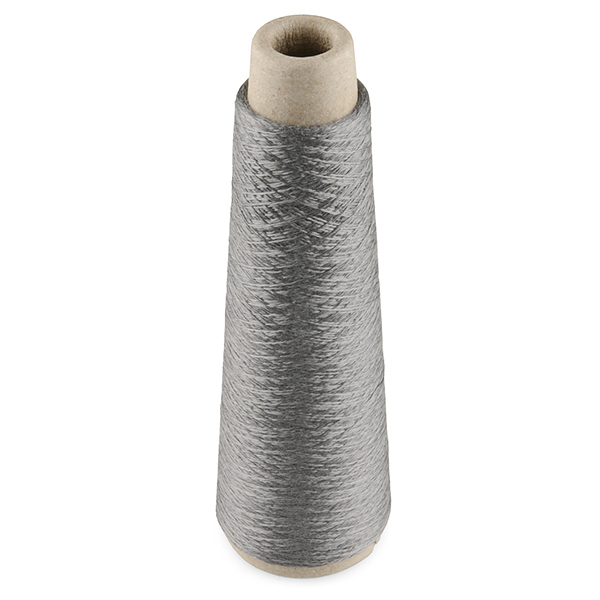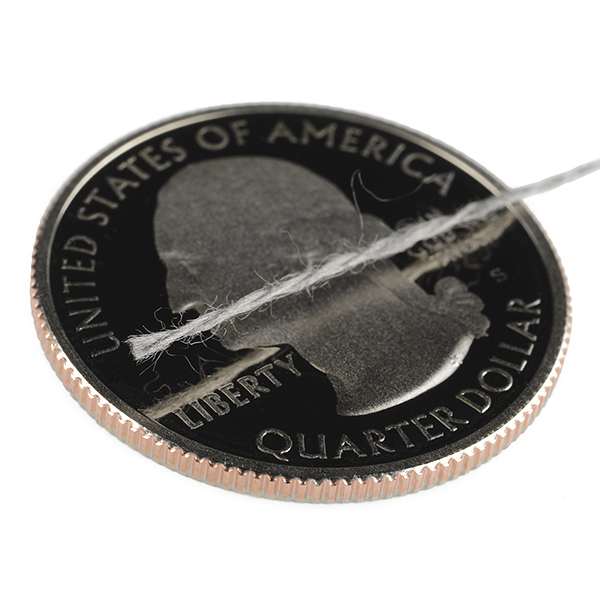Conductive Thread - 60g (Stainless Steel)
This is about 360 yards of conductive thread spun from stainless steel fiber and wound on a spool. You can use it as a creative way to connect various electronics onto clothing projects. This large spool is a great way to get into wearable electronics without a large upfront cost and a large enough quantity to not be afraid of making a few mistakes.
What sets this thread apart from the other conductive thread that we carry is the fact that it's actually spun from stainless steel fibers (as opposed to plated silver) and doesn't have a Nylon core. This means that while it may not be easy to solder to, because it's stainless, it also won't burn up when you touch it with a soldering iron. Also, it's somewhat 'hairy' and can be slightly more difficult to work with in close, fine conditions than the other thread. Our resident E-Textiles expert suggests waxing the thread for hand sewing, as this should take care of any 'hairy thread' issues. Since waxing is impractical in machine sewing applications, avoid sewing close connections by machine as the 'hairs' could potentially short across small distances.
- Made from Stainless Steel Fibers
- Resistance: 28 Ohms/ft
Conductive Thread - 60g (Stainless Steel) Product Help and Resources
LDK Experiment 5: Make Your Own Switch
October 2, 2013
Learn to create and integrate your own handmade switch into an e-textile circuit.
LilyPad Basics: E-Sewing
December 17, 2016
Learn how to use conductive thread with LilyPad components.
Core Skill: DIY
Whether it's for assembling a kit, hacking an enclosure, or creating your own parts; the DIY skill is all about knowing how to use tools and the techniques associated with them.
Skill Level: Noob - Basic assembly is required. You may need to provide your own basic tools like a screwdriver, hammer or scissors. Power tools or custom parts are not required. Instructions will be included and easy to follow. Sewing may be required, but only with included patterns.
See all skill levels
Comments
Looking for answers to technical questions?
We welcome your comments and suggestions below. However, if you are looking for solutions to technical questions please see our Technical Assistance page.
Customer Reviews
4.6 out of 5
Based on 11 ratings:
1 of 1 found this helpful:
great amount, great price
SO glad theres finally an option to buy thread in larger quantities than tiny bobbins!
Works, but somewhat weak.
It's a great quantity for working with classrooms and maker spaces, but its tensile strength is somewhat low. Even sewing something simple I managed to break it a couple of times. That's frustrating for me and young people.
Sorry to hear that the thread would rip on you from time to time. It's a decent thread, but certainly different and slightly more fragile from your standard spool you might find at a craft store.
Works as expected
I have no basis for comparison as this is the first time I have done anything with eTextiles. It works as I'd expect. It can snap if pulled too hard which is mostly not a problem as only the students who sew very messy get tangles. I do find that it is helpful to run the end over some beeswax and then snip the end to thread it through the smallest needle eye. You could just use a thicker needle but for the project we are doing, we need small needles. The students are loving the project and are not complaining about the thread so I'd say it is great. It would be nice to be able to run it through a sewing machine if I were doing a big project but for simple projects, it is great and I am quite happy with it.
Conducts!
Definitely does what it says it does. Thanks! :)
Good
nice to wereables
Students having trouble threading needle
Our Family and Consumer Sciences teacher says: The conductive thread is fine. I like it. The problem is having middle school students thread it into needles and sew through the sewing holes of the battery holder. I am using the Coin Cell Battery Holder (20 mm sewable) DEV-08822 ROHS.
I have discovered size 7 embroidery needles have the largest eyes yet are small enough to fit in the sewing holes of the battery holder. I would love to have larger needles to make it easier to thread but then they are too big to sew with.
Having 100 seventh and eighth graders thread needles was really tough. This time I am having 75 students do the project. So, I have purchased "easy threading needles - sizes 4-8" that have a slot in the top to just pull the thread down into the eye. They will fit in the battery holders. They are much more expensive needles. By next week my students will try them and I will know more about whether or not students can thread them and use them easily with the battery holder.
All needle threaders I have tried simply break when students use them.
Do you have a different kind of battery holder that would substitute for this one and help solve my problem? I am having a lot of fun making LED sewing projects with the students and need to expand my knowledge!
Miss Edith Rohrer, Edgewood Middle School, Warsaw, IN
Hi, There's one other battery holder, though it is more expensive. Have a look at [https://www.sparkfun.com/products/11285](LilyPad Coin Cell Battery Holder)
I don't know that it's the best thing, but it's up there! My first E-textile was a success the first time around.
Great
This thread is working well on my wearable art project. Highly recommend!
Great deal!
I have sewing machines at school for MakerSpace so I can easily spin the thread onto bobbins that run out. Quality is the same as the conductive thread on the bobbins, but now I can easily fill them up at a lower cost than purchasing the bobbins again! And I can reuse the bobbins!
Good conductive thread
I purchased a roll for the maker club I run and it worked great the kids had a lot of fun making everything from light up bracelets to bow ties.
Great conductor of electricity
It looks like thread, It acts like thread, but you can make a circuit with it. Whatever you want to incorporate into your fabric, an led, a vibrating motor, you can do it with this thread.




 Replaces:
Replaces:
To the teacher who reported that the students had trouble threading the needles, I purchase several inexpensive needle threaders and the students had no trouble once they learned how to use them.
I used this and the Lilypad ProtoSnap recently with sixth-grade students to complete a project on electricity. We sewed simple patterns on felt, drew out the circuits, and sewed parallel circuits. I was great! The loved it and they learned basic sewing in the process. You would be surprised how well the boys did! I have one suggestion that I will also post with the conductive thread item, you should make the conductive thread in two different colors so the students can keep track of positive and negative lines. Next time I do the project, I will have them use a Sharpie to die some of the thread RED for the positive lines.
Thanks for the feedback, I will pass the information on about possibly color coding the thread.
As a note, I would test the die or Sharpie on a small section of the thread first to make sure it still provides a good electrical contact. There is a chance that the coating might act as an insulator and prevent the thread from functioning.
What is the diameter of the Conductive Thread - 60g (Stainless Steel)?
Hi! Does this thread support high temperature over time? I am planning to make warm socks heating them up by puting the thread in short circuit with a battery.
I have been working with these SS threads for about 4 years now. If using on a sewing machine, once you get it on the bobbin, brush the bobbin liberally with an oil like olive oil and let it soak through. This will help minimize breakage as the SS comes through the foot plate on the machine.
Is it the same thread than the bobin?
Hello, is this the same as sold on the bobbins? What is the aproximate length of the 60g spool? I am looking for an inexpensive thread to use for projects at the school I occasionally work at. Is it easy to handle (rigid, easy to sew)? Thanks :-)
//Edit: In another webshop I have read ~360 yards, is that realistic?
can i use this to sew in my backpack..? i have a project to be made and i need to use this thing..answer me asap because i will buy.
You should be able to use this for pretty much anything you would use regular thread for. Its a little thicker, but as long as you know how to use a needle and thread you should be able to sew this in your backpack.
will this thread heat up so that it could be used with thermochromic paints?
Anything heats up if you put enough current through it (as long as it is not at near absolute zero temperatures). The question is how much current is required to get it to heat up to a noticeable value. So what the resistance is would be a good question that I would also wonder. Are there any data sheets on this?
The resistance is 28Ohms/ft. If you double up the thread, that cuts the resistance in half.
Simply doubling up the thread won't work. 2X the tread means more current needed to heat up the thread, I'm not sure how much more current though.
Is there a data sheet for this? I'm interested in the current limit.
I wonder if this would work for creating lighting stikes if you tie one end to your model rocket?